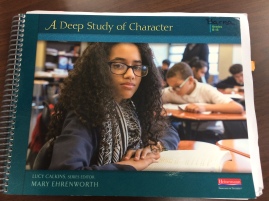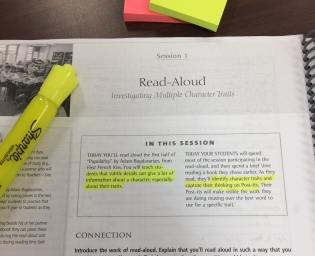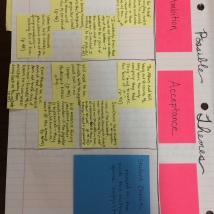It’s no secret that my school district uses the Teachers College Reading and Writing Units of Study, so when the middle school reading units came out I was beyond stoked. Navigating reading workshop at the middle school level has been difficult. There are SO MANY resources out there (on the web, Pinterest, Twitter) for lower grades. It was easy for me to conceptualize how to make the thinking work of lower elementary readers apparent to students, but I struggled with the higher-level analysis required of a middle schooler. How exactly do we show readers how to synthesize information across a text or how to move beyond simply teaching identification of narrative elements and instead, showing how they interact and influence each other.
As the required thinking work gets harder, making what happens in my mind so naturally as a reader, is harder to break down into a step-by-step strategic manner. BUT the new Middle School Reading Units of Study put out by Lucy Calkins and colleagues (including the fabulous Emily Strang-Campbell) do just that! They break down really complex thinking into simple easy to follow minilessons. The work is not for the faint of heart… Students and teachers are asked to do a level of work that many may not be accustomed to, but the payoff is well worth it!

Needless to say, I am VERY excited! So, when the Deep Study of Character unit got delivered to my door, I was so ready to dive right in and start figuring the unit out.
I began by scanning the lessons for two things:
- What am I teaching?
- What are the students doing?

I used to do this work by first reading the Teaching Point (to see what I am doing) and then reading the Link (to see what students are to do). HOWEVER, unlike any of the other grade-level units, the middle school units have a spectacular “In This Session” feature, that clearly states that information at the start of the session. So smart!
To wrap my head around the work of Bend I, I first created a Demo Reading Notebook using the anchor text “Popularity” by Adam Bagdasarian. This was really helpful. By pushing myself to do the work expected of students, the teaching of each session became more clear.

Here are some more pages from my notebook. 🙂
There is a page of thinking work for each session of Bend I as well as a homework page.

Usually suggested homework is to read (obviously) and do some thinking work. Students may either return to work started in class or begin something new. Just for demonstration purposes (for the teachers I work with and for students), I created a new entry type for each day of homework. I chose a variety of different styles so that an assortment of entries were exemplified.
A couple of new ideas I’ve had about notebooks after this process:
- When assessing them (because unfortunately yes, we are a slave to grades at times), I would expect to see some evidence of the work taught each minilesson. It may not be great or mastered, but students should be making an attempt to approximate the thinking work taught. So, in terms of the Deep Study of Character unit, in Bend I I would expect to see evidence of students naming character traits, tracking traits and revising their initial ideas about characters, identifying likeable and unlikeable sides in characters, weighing and ranking traits based on their dominance or tendency to affect the plot, and analyzing the pressures characters experience. In addition, I might see students doing one or two pages of “other” work. Something they thought of on their own or were shown during a small group or conference.
- REMEMBER notebook pages are often Thinking, Return-to Pages. A fully completed notebook exemplar is NOT created in one sitting. It may be developed over the course of a couple days as students progress through their book. It is constantly being added two as student learn more about their character, revise their ideas, include new evidence, etc. Imagine an Emotional Timeline- students would begin it at the start of a book with some initial ideas about the character’s state of mind and add to it as they proceed through the events of the novel.
- With this idea in mind, the logistics of when notebook pages are created was clarified. I always understood that they had to be done, but the question was WHEN? If students are expected to spend the majority of their time reading, when do these marvelous notebook entries happen? However, once I realized that notebook entries are returned to, it became more apparent. Students should be spending a couple of minutes each day (and night for homework) adding to their notebook entries.
How have you acclimated yourself to this new unit?? Please share!!!!
Let’s keep the conversation going-
Lindsay








Great work. All teachers of workshop could benefit from your process.
LikeLiked by 2 people
Thank you! Helping teachers is EXACTLY what I love to do!!
LikeLiked by 1 person
This is just FABULOUS and so very helpful! Are you using just a regular spiral notebook for your demonstration notebook? Thank you!
LikeLike
Thank you, and yes. While I’ve seen some use a sketch book, my goal was to create a reading notebook similar to what students might create. Maybe a better name would be a notebook exemplar. 🙂
LikeLiked by 1 person
I’ve tried a sketch book, and it just didn’t quite work for me. I love the idea of using a regular notebook. Thank you for so generously sharing your work and thinking—truly an inspiration!
LikeLiked by 1 person
This is fabulous, and exactly what I am trying to do with my students! How do you assess them, and how often? I struggle with this because, as you mentioned, the entries are often works in progress and not created in one sitting.
LikeLike
My thought is to assess entries at the end of each unit as well periodically throughout. If you use the Calkins Units of Study, the bends are natural stopping points. After a Bend (or section of a unit) each student should have some evidence of the work taught via the mini lessons in that bend- though those entries may not be fully flushed out. So I spot check along the way to see that students are doing the necessary thinking work at the appropriate level, but don’t expect finalized entries until the end of the unit. When looking at final entries I might check for the habit – is there evidence that the student regularly adds to his or her notebook? Is there evidence that the student is attempting the thinking work that has been taught?- as well as the content- are the entries complete, grade-level appropriate, “up to snuff” in regards to the work the student has done. I also might only grade a few entries for content. I’d have the student flag (with a sticky) their two or three best entries. In a regular unit that would be two midway check points and one final. What do you think??
LikeLike
And THANK YOU for your kind words! 🙂
LikeLike